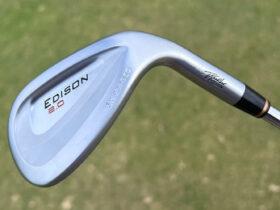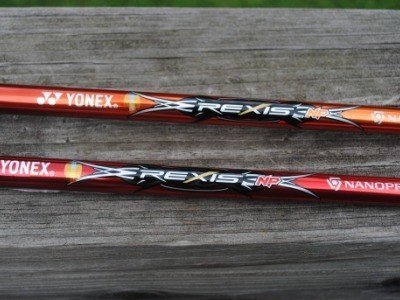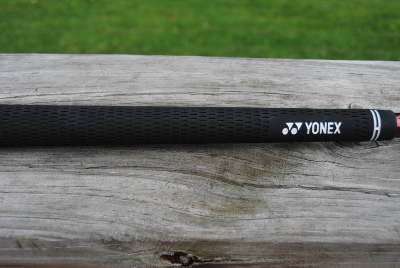Yonex Rexis NP Shaft Review
I have been watching golf now for about 20 years. Fortunately, I am more interested in the sport now than I ever have been but it is enlightening to reminisce on things I remember or recall. One particular company that has always had a presence on Tour, whether it is big or small, for as long as I can remember is Yonex. As a lefty, and a Phil Mickelson fan, I can remember when he was giving us that same sly smile and that same long meandering walk up the fairway while rocking a Yonex visor. I remember watching the massive Reverse C finish of Colin Montgomerie’s golf swing, all the while he was wearing a Yonex visor. Today we have an International star and perhaps one of the next big things on the PGA Tour, in Ryo Ishikawa who now carries the Yonex torch and does so with a style and golf game that is taking the Tour by storm. My point is, Yonex has been in the golf game for as long as I can remember, and not only have they been in the game, they have been represented by some of the biggest names in golf.
Yonex has always been known for their high-end quality line of golf clubs but at the PGA Merchandise show in 2012 they unveiled the Rexis NP series of shafts. Yonex was kind enough to send a few of their Rexis NP offerings to THP for testing and I was lucky enough to be able to put them through the paces.
TECHNOLOGY
I will just go ahead and throw this out there, but there is little to no information about the Rexis NP shafts on the internet. At first I kind of panicked because I do like to post some technical material from the company in my reviews. I assume, and I hope, I have some readers out there who enjoy that aspect when reading about shafts. After a brief panic session I thought about how it is actually kind of cool to go into this testing with little or no information about a shaft. Who knows how much some of my findings and discoveries might be altered due to some sort of predetermined notion because I know what a shafts “characteristics” are. I would like to think that I do not do that but I would say it’s hard not to ignore things you know when going through a testing like this.
What I do know about the Rexis shafts from Yonex is that Yonex’s expertise in composite graphite technology has lead to the creation of the Rexis NP (Nanopreme) shaft. Nanopreme is a high intensity, extremely elastic material that provides increased energy transfer and superior shaft stability. This is something that major shaft manufacturers are focused on right now in this industry. The ability to provide the market with a shaft that can enable faster club head speeds, yet reduce shaft deformation, is what’s driving shaft R & D at the moment. Based on some research I found, Nanopreme scored improvements of 14%, 21%, and 24%, in flexural strength (bending strength), flexural modulus (stiffness), and impact strength (external shock/impact) when compared to conventional carbon materials. What does all this mean to the consumer? Yonex has a product in the Rexis NP shafts that are lighter, stronger, and more resilient than any existing golf club shafts on the market. The end result for the golfer is simple: greater distance.
What Yonex did with this Nanopreme technology was create 3 Series of Rexis shafts: the L Series (Low Kick point), the M Series (Mid Kick Point), and the H Series (High Kick Point). Each series has Nanopreme composite integrated from the shaft’s kick point to a specific section of the shaft. Obviously, the L Series focuses on the tip-section, the M Series is incorporated throughout the mid-section, and the H Series is concentrated on the butt-section of the shaft. This results in 3 different shafts that offer 3 different characteristics which should cater to the majority of the golfing population. The L Series offers a “high launch, mid-high spin, and greater repulsion power. The L Series targets the golfer who is seeking a higher trajectory and added response for greater carry distance, enhanced feel and improved consistency.” The M Series is touted as more smooth and stable and targets the player who is looking for “mid to high launch, moderate spin, and a penetrating trajectory. The M Series is for players who prefer increased launch conditions with more stability.” Finally, the H Series offers “low launch, low spin, and flatter trajectory for the stronger player looking for maximum control and stability.”
In the end, Yonex has created a series of shafts that features ground breaking technology that can benefit the needs of any golfer.
LOOKS
If looks could kill then these shafts would be serving a life sentence. No, I’m dead serious. You might be thinking, “but Lucas, these are plain and offer little graphics”. I would agree but there is something so incredible about the depth of the colors Yonex chose for these shafts. Yes, the L Series is Red, the M Series is orange, and the H Series is blue, but the way each color starts in a deep, dark tone at the butt end of the shaft and work their way into a brighter, bolder version of themselves as they approach the tip section of the shaft is appealing to me. Almost as if the color itself, and the way it morphs from one end of the shaft to the other, is a representation of energy, energy that starts in the hands and explodes on the golf ball at impact.
I also feel that the minimal graphic approach offers a clean look. Very stream lined, very modern, very far eastern-ish, and well, very Ryo Ishikawa-ish. In my opinion, the colors chosen to represent the 3 Rexis series shafts are very fitting and appropriate. Yonex equips their Rexis shafts with the Golf Pride Tour Velvet grip. The only graphics on the grip is a simple one, a white “Yonex” which replaces the white “Golf Pride” that Tour Velvet users are familiar with.
TESTING
Yonex was kind enough to send the L Series (Red) in Stiff flex and the M Series (orange) in Stiff flex for testing. Both shafts came equipped with the stock Yonex/Tour Velvet grip and were tipped to go in my Taylormade R11S. A little bit about me before we embark on our testing journey. I have been testing shafts for THP for around a year or so at this point. I am currently a 0.7 handicap golfer and much prefer precision and control over bombing and gouging. I have never been the greatest driver of the golf ball but it is an area in which I have seriously improved over the last couple of years. I am a firm believer in course management and love playing on golf courses that demand accuracy, precision, and discipline. My R11S driver has a 9* head and for the sake of testing all settings are left in Neutral positions.
I was able to spend time with each shaft, approximately 4 rounds of golf with each and a couple of range sessions. At this point in the golf season the bulk of my time is spent on the course and not on the range. I dedicated my initial time with the L Series (Red) Rexis shaft. The L Series Rexis in stiff flex comes in at 63 grams, has a torque of 3.3, and a low kick point. The first time I hit it was on the first hole of my golf course. It’s typically not a driver hole as it is a short par 4 that features the most danger near the green. I hit driver. I know, that’s not the course management I mentioned I like to play but I was excited to try it out immediately. What I saw and felt immediately made me smile. I saw a ball flight that was actually a little lower than I am used to. I saw my golf ball settle up about 5 yards short of the front of the green (it’s a short par 4, 328 yards from the tips). Safe to say I was off to a very good start with the L Series shaft. I thought the shaft performed fantastically throughout my experiences with it. Not once did I feel like it was too stout or too heavy or if it was just too much for me. To claim it’s a “high launching” shaft surprised me, especially as a natural high ball hitter. The trajectory seemed to be ideal on the golf course and something I could easily live with.
As much as I enjoyed the L Series Rexis I have to be honest, the M Series was the one I was most looking forward to. Mostly because I know that a shaft with mid launch characteristics typically fit me and my swing the best on the golf course. What was really interesting about switching to the M Series was that it felt no heavier, no stouter, and certainly no stiffer than the L Series. The M Series Rexis in stiff flex weighs in at 66 grams, has a torque of 2.6, and a mid kick point. It was such an easy transition. When I finally put this shaft into play I could only say one thing over and over: WOW! Immediately I knew this shaft was a winner for me. I finally found that lower ball flight off the driver that seems to minimize lateral movement and run for days once it hits the fairway. This is a newish experience for me and one that I quite enjoyed in my time testing this shaft.
On course results are going to be different for everyone, as we’re all searching for different results that we call “optimal”. One thing I like to incorporate in all of my testing is launch monitor results. I put the L Series Rexis and the M Series Rexis on the Vector in order to collect some data to share. For the Vector results I used the Taylormade R11S head (9*), all setting left on Neutral, and a Bridgestone Tour B330 golf ball. I hit 11 shots with each driver/shaft combination and threw out the worst drive in order to get a 10 shot average. Here are the results:
L Series Rexis (Stiff flex) Averages
• Clubhead Speed – 112 mph
• Launch Angle – 16.7*
• Backspin – 2801 rpms
• Ball Speed – 158 mph
M Series Rexis (Stiff flex) Averages
• Clubhead Speed – 111 mph
• Launch Angle – 14.2*
• Backspin – 2388 rpms
• Ball Speed – 161 mph
In the end, both very solid performers for me! What was interesting was seeing how much more ball speed I got out of the M Series. Personally, I think that’s due to having something with a mid kick-point for my golf swing. The best thing about testing both of these shafts is that I could easily game either of them in an instant.
CONCLUSION
I never knew that Yonex made shafts. I have never had the chance to try a Yonex product prior to these. Am I forever thankful that I had the chance to? Absolutely! In my opinion, Yonex has a product in their catalog that rivals some of the best shafts I’ve tested in the span of 2 years. The Rexis NP series of shafts have some characteristics that cater to my needs: light weight, stable, appealing to the eye, consistent, and most importantly, phenomenal numbers from the Vector.
For more informatin on Yonex please visit their website www.yonex.com.















Great review Lucas. Man check out the difference in numbers between those 2 shafts. Just goes to show what a proper fitting could lead to for people. Like you, I didn’t know Yonex made shafts until THP Demo Day.
Great review TC I’ve been waiting for this one for a while and it did not dissapoint. I’m going to have to get my hands one of these shafts in the near future.
Great review TC. The number are straight up awesome with that M series dude. 3 more mph ball speed while swinging 1 mph slower? Heck yes, sign me up! Yonex again impresses with their products, I would like to see more of their products in the US, I think that’s where we’re headed and with solid reviews like this I’m sure we’ll see more and more soon.
Very good review, Lucas. Always enjoy reading these reviews you do, packed full of info for those of us who are just now learning about the world of shafts! Thanks!
Great and thorough review Lucas. Like you (until now for you) I have never had the opportunity to try any of the Yonex shaft offerings, but maybe this is something I need to take a look at. Thanks again for a great review buddy.
It really sounds like you found a winner in that M series, TC. I think just about anybody would kill for numbers like that!
TC, fantastic review man. The Yonex R&D department has got to be awesome. Super glad they put these in for review. I’d love to get my hands on one for a whirl.
Great stuff man.
Like the review, Lucas. I am pretty uninformed about shafts and pretty much rely on you for the info (even going so far as pm’ing you about shafts for the SuperFast I bought a few months ago).
Mercy! What a review dude, that was packed with quality info and delight to read. Great work Lucas.
Another very solid and detailed review. Sounds like some high quality shafts with the performance and good looks!
That is such an awesome review! Really intrigued to try one of these shafts.
Lots of info there Lucas,good job explaining. I agree with the colors, I have a Yonex shaft in my hybrid and I love the deep color. Just one question, what about the shafts are ishikawaish?
Fantastic review. Really liked your first tee shot results. I also liked seeing the numbers you got on the monitor. Sounds like Yonex has a winning product on there hands.
Well done TC. I enjoyed this review a lot. Seems like these shafts are really awesome. I’d love to try them some time.
Fantastic review TC!!! After what I have read, I am very much interested in checking these Yonex shafts out.
Really great review TC, I enjoyed reading through that.
Yonex really does seem to make a great product. All the way through the lines, all the feedback from demo days and testings have been overwhelmingly positive.
I really liked how you went into this testing without a lot of technical info, and just got swinging. No way I’d have expected you to come away impressed with a shaft touted as high launching and mid/high spin, but I guess that speaks to the effectiveness of the tech incorporated into these products – seems like just about anyone could game one of these shafts and be able to tell the quality.
Great review TC, I like reading about Yonex equipment. It’s one company that I really want to try out.
Very nice review Lucas! That M series sounds like the offering which would probably suit me the best. There are so many shaft options out there and I thoroughly enjoy reading your reviews as it helps to “remove the clutter” in my head by just looking at a label or reading the OEM’s launch characteristics.
Man that M series was perfect for you Lucas. Great review. Those shafts look sweet!
Excellent review TC! Very well done. I agree with you and everything you wrote about Yonex. Great info on some impressive shafts!
Great review Lucas. It sounds like Yonex continues to put out the very high quality equipment we have come to associate them with.
Great write up…..I love my Yonex 380 cc driver with the M series Rexis shaft in it.
And you never disappoint with a review big man! Anxious to get one of these shafts and try it out. I think a high launch shaft could be a lot of fun. Fantastic dude!
Those numbers speak for themselves, nice review Lucas
Excellent review and a nice read. Yet another shaft that’s piqued my interest. 😉
I like the comparison between on course and launch monitor findings. Wish Golf Galaxy or GolfSmith provided a wider range of shafts to hit on it’s monitors! Good review.
Where can you purchase these shafts?
Inceedible review Luke! Color me interested!
Fantastic review Lucas! I also never knew that Yonex made shafts but I have to agree with you that these are some of the best looking shafts on the market and from those #’s it looks like they perform just as great. Well done dude, would love to get a hold of one of these to test out.
Enjoyed the review. I wish my local golf store (Golf Galaxy) carried Yonex equipment to try.
I use a Yonex gap and sand wedge, but they are old models (ADX 100i), but the grooves are still good.
Both have graphite shafts, and I like them. Nowadays it is tough to like a lot of the graphite shafts made for irons, as there is so much disparity between models and brands.
I was surprised that the S flex shaft seemed to fit you well, considering your swing speed of 111 mph and 112 mph. Nowadays most companies list their S flex shafts for a range of around 95-105 mph, so I would have expected an X flex shaft for your game.
It seems kind of rare when a company makes their own stock shafts nowadays instead of using a well known aftermarket branded shaft, but then watering it down and having that “designed exclusively for ‘Titleist, TaylorMade, Nike, whatever'”.
Yonex made good shafts of their own, and Mizuno had very good shafts of their own brand, which they called Exsar, though they’ve added aftermarket options now too.